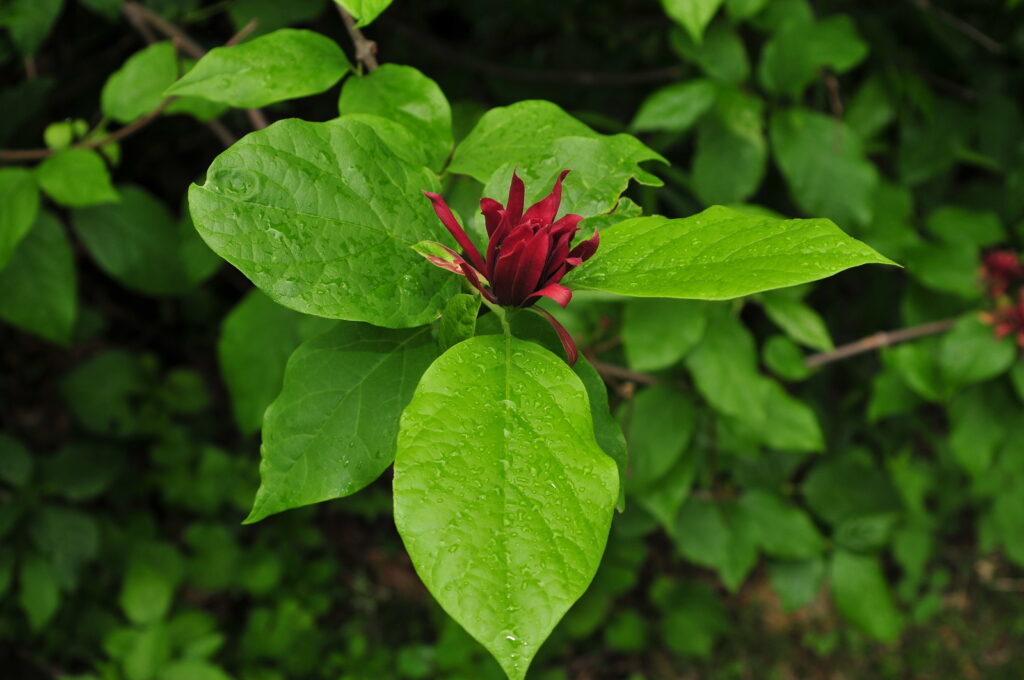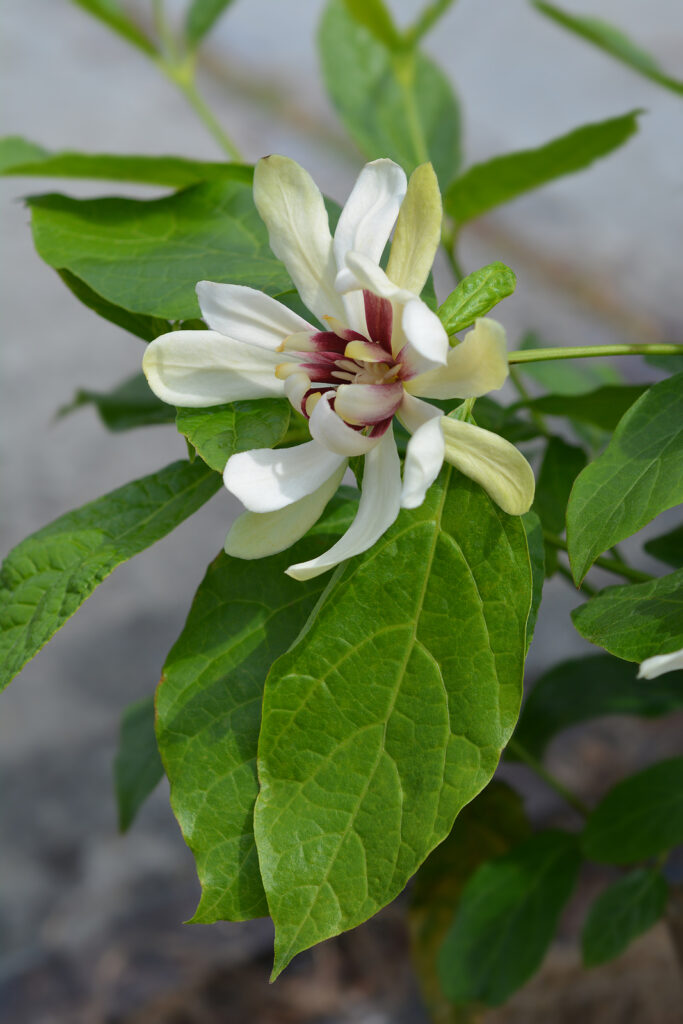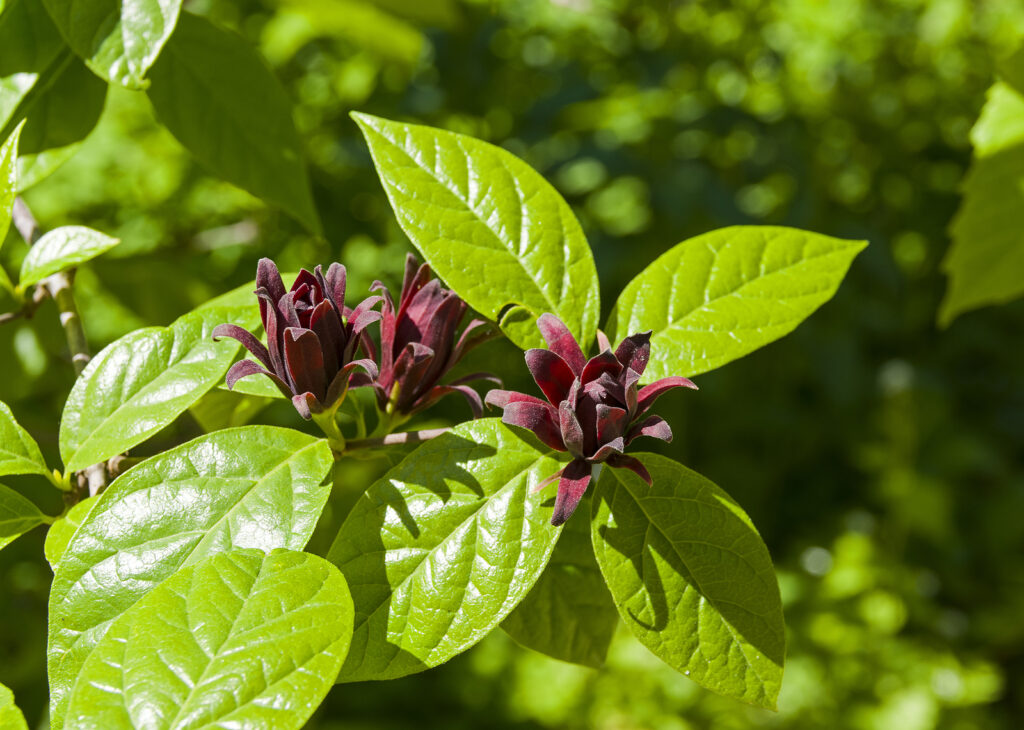Calycanthus–commonly called Carolina allspice–is a large, bulky shrub with lush foliage and unusual, fruit-scented flowers. Calycanthus flowers are narrow and lance-shaped; they resemble tiny waterlilies.
Calycanthus is a deciduous shrub native to woodlands and streambanks. It is a good choice for a border, for a summer flowering hedge, or as specimens.
Calycanthus flowers on the current season’s wood so it can be cut back close to the ground in autumn. As a seasonal fragrant hedge, it grows 6 to 10 feet (2-3m) tall and 10 to 12 feet wide.

Get to know Calycanthus
- Plant type: Deciduous shrub
- Growing zones and range: Zones 5 to 9
- Hardiness: Hardy to Zone 5
- Height and width: 6 to 10 feet (2-3m) tall and 10 to 12 feet wide.
- Foliage: Opposite dark green leaves from 2 to 8 inches (5-20cm) long that are clove-scented when crushed.
- Flowers: Deep reddish blooms with elliptical petals that resemble small water lilies; they are usually fragrant.
- Bloom time: Summer
- Uses: Combine with other shrubs in a border.
- Garden companions: Blue and white cultivars of French hydrangea (Hydrangea macrophylla)
- Common name: Carolina allspice, sweetshrub
- Botanical name: Calycanthus
- Family name: Calycanthaceae
- Origin: Woodlands and streambanks in the United States
Where to plant Calycanthus
- Plant Calycanthus in full sun in cool-summer regions and partial shade in hot summer regions.
- Plant Calycanthus in humus-rich, moist soil that is well-drained.

When to plant Calycanthus
- Plant Calycanthus seed as soon as it is ripe in the fall or sow seed in spring.
- Set container-grown plants in the garden in spring or autumn.
Planting and spacing Calycanthus
- Space Calycanthus 10 to 12 feet (3-3.6m) apart.
How to water and feed Calycanthus
- Keep the soil evenly moist for best growth.
- Feed Calycanthus with an all-purpose organic fertilizer in spring.
How to care for Calycanthus
- Calycanthus flowers on the current season’s growth; prune Calycanthus to the ground in early spring.
Calycanthus pests and diseases
- Calycanthus can develop leaf spots, powdery mildew, or dieback.
- Calycanthus has few garden pests.

Calycanthus propagation
- Sow seed as soon as ripe in autumn; grow seed on in a cold frame.
- Take softwood cuttings of Calycanthus in early summer.
- Layer Calycanthus in autumn or remove suckers in spring.
Calycanthus varieties to grow
- Calycanthus chinensis, Chinese spicebush: Grows 6 to 9 feet (1.8-2.7) tall and bears huge gloss leaves; 3-inch white spring flowers are tinged with pink and have yellow centers but no fragrances.
- C. floridus, common sweetshrub, Carolina allspice: native to the eastern United States; grows to 8 feet tall and 10 feet wide; dark green leaves to 5 inches long; 2-inch maroon flowers with straplike petals can smell like strawberries, bananas, or pineapples’ cultivar ‘Athens’ has very fragrant yellow flowers.
- C. occidentalis, California allspice: West Coast native similar to eastern but grows larger.



